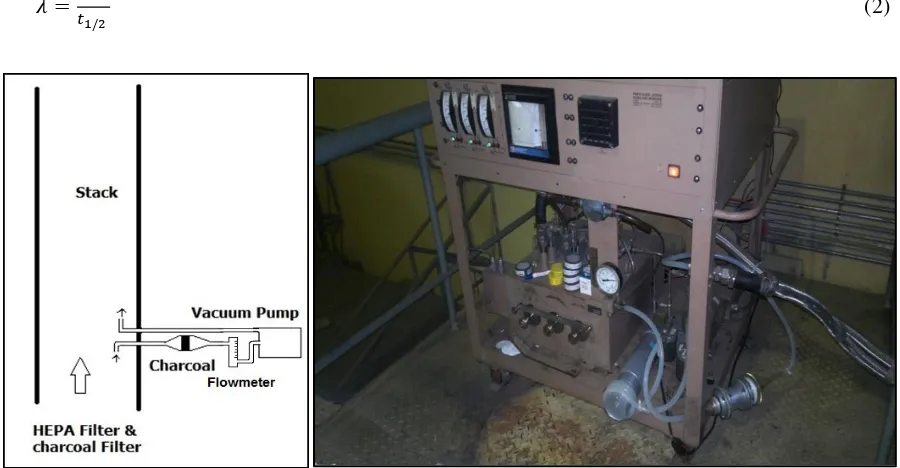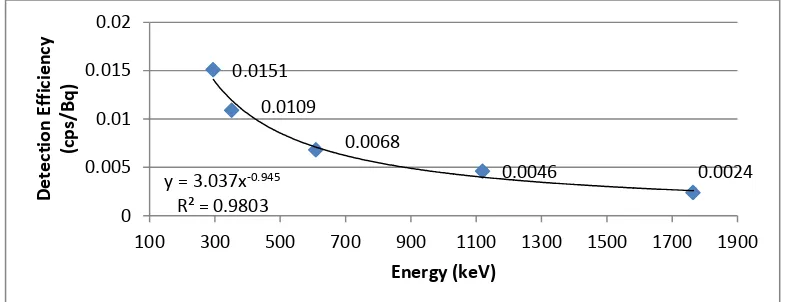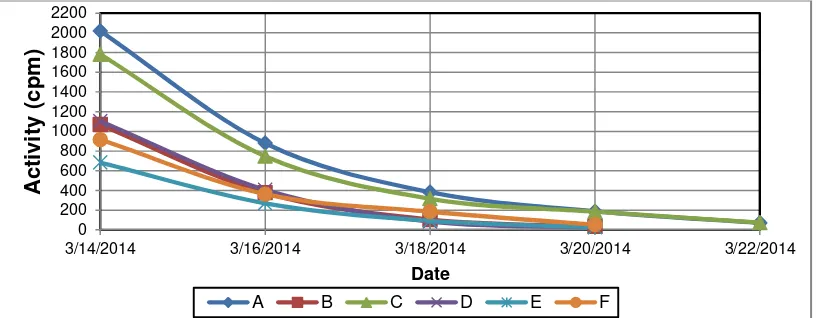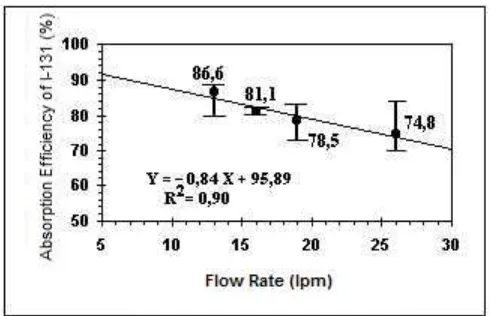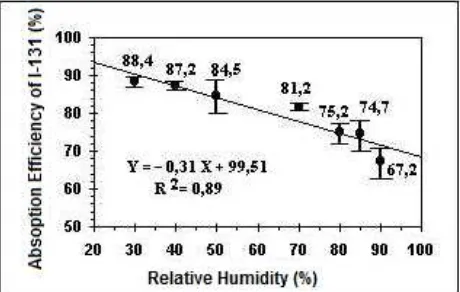See discussions, stats, and author profiles for this publication at: https://www.researchgate.net/publication/280580903
Absorption Life Time of Iodine-131 in Charcoal
Filter on the Airborne Measurement in Stack
Before Released into the...
Conference Paper · August 2014
CITATIONS
0
READS
282
4 authors, including:
Some of the authors of this publication are also working on these related projects:
Justification for radiation and nuclear safety regulationsView project
Iodine-131 air monitoring of stack release from radioisotop production facilityView project Gatot Suhariyono
Badan Tenaga Nuklir Nasional
23PUBLICATIONS 4CITATIONS
SEE PROFILE
Aye Syahrir
Badan Tenaga Nuklir Nasional
2PUBLICATIONS 0CITATIONS
SEE PROFILE
All content following this page was uploaded by Gatot Suhariyono on 01 August 2015.
Proceedings of the 3rd Applied Science for Technology Innovation, ASTECHNOVA 2014 International Energy Conference Yogyakarta, Indonesia, 13-14 August 2014
Absorption Life Time of Iodine-131 in Charcoal Filter on the Airborne
Measurement in Stack Before Released into the Environment
Gatot Suhariyono
PhD Student, Postgraduate Program on Environmental Science, University of Indonesia Jakarta, Indonesia
National Nuclear Energy Agency (BATAN) Jakarta, Indonesia,
[email protected], [email protected]
Haryoto Kusnoputranto
Department of Environmental Health, Faculty of Public Health and Postgraduate Program on Environmental Science, University of Indonesia, Jakarta, Indonesia
Kardono
Air Pollution, Center for Environmental Technology
Agency for Assessment and Application of Technology (BPPT), Jakarta, Indonesia [email protected]
BATAN TECHNOLOGY (BATEK) in Serpong produces Iodine-131 (I-131) routinely for medical needs. Measurements of I-131 airborne in a stack of the BATEK radioisotope installation before being released into the environment has been carried out routinely by using the charcoal filter. Many researchers who do not know the characteristics of the I-13 absorption in charcoal filter were surprised with the results of measurements of I-131. By the time measurement I-131 activity was performed by using gamma spectrometry, the activity of I-131 majority was not detected after a half-life of I-131 (8.04 days). This is due to the absorption life time of I-131 in the charcoal filter. The absorption life time of I-131 is different with half-life time of I-131 in the charcoal filter, because the presence of the absorption life time of I- 131 in the charcoal filter is affected by the flow rate of pump, air temperature and humidity inside the stack. Therefore, research on the absorption life time and absorption efficiency of I-131 in the charcoal filter has been carried out as a function of temperature, flow rate and humidity. The measurement of I-131 absorption efficiency has done on temperature of 30 oC to 45 oC, flow rate of 13 lpm to 26.3 lpm and relative humidity of 30% to 90%. The result showed that the average absorption life time of I-131 in the charcoal filter is 1.497 days. The result of research show that on the temperature performance increase of 30 oC to 45 oC has the absorption efficiency I-131 in charcoal filters increase from 72.4% to 83.3%. The flow rate increases from 13 lpm to 26.3 lpm, so absorption efficiency decreases from 86.6% to 74.8%. The relative humidity increases from 30% to 90%, so absorption efficiency decreases from 88.4% to 67.2%.
KEYWORDS: I-131, Iodine, charcoal, stack, absorption, half-life, life time, environment
1 INTRODUCTION
BATAN TECHNOLOGY (BATEK) produces some radioisotopes for diagnostic and therapeutic purposes in the field of nuclear medicine in the hospital, and pharmacy, both for domestic and international needs. One of the many radioisotopes produced BATEK is I-131. I-131 gas emissions escaping from the stack can be dispersed into the environment (water, grass and soil), and it can enter to the animal and human respiration. Releases of radioactive contaminants to the atmosphere can occur, either in a nuclear accident as well as under normal conditions. The nature of the I-131 isotope is volatile and has a thyroid critical organ (Zubaedah et al., 1989). Radioactive releases from the stack of concern may exceed the limit of I-131 radioactivity release into the air environment (85.000 Bq/hour) and quality standard of radioactivity levels in air (530 Bq/m3) based on regulation of PERKA BAPETEN No. 7/2013 about Environmental Radioactivity Limit Value (BAPETEN, 2013). Therefore, routine monitoring of I-131 activity concentration in the stack before released into the environment is important.
Monitoring of I- 131 radioactive gases in the stack of nuclear facilities is an important factor in the operation safe and safety of the environment around nuclear installations. Air monitoring of I-131 in the stack need special sampling tool is activated charcoal filter that added Tri Ethylene Di Amin (TEDA) or Potassium Iodide (KI), so that I-131 in the form of Methyl Iodide (CH3I-131) gas is absorbed permanently (Figure 1). I-131 activity in the charcoal can be measured with a gamma spectrometer with NaI (Tl) detector.
Some researchers sometimes did not immediately take measurements of I-131 activity in the charcoal, after sampling in a stack. This case is most likely because the researchers estimate the activity of I-131 in the charcoal filters after a half-life of I-131 (8.04 days) expected to be absorbed half of the initial activity. Many researchers who do not know the characteristics of the I-131 absorption in charcoal filter were surprised with the results of measurements of I-131. There are some activities of I-131 that is in the charcoal filter is not detected, after a half-life of I-131 is exceeded. Therefore it is necessary to study the existence of I-131 in the charcoal filter. One of the studies that will be done is to know the absorption life time of 131 in charcoal. The absorption life time of 131 is influenced by the absorption efficiency of I-131.
Absorption efficiency of I-131 in the charcoal filter is affected by physical parameters, such as temperature, presence of organic matter, adsorbant thickness, flow rate, and humidity (Xia Hua, 1996, Kato, S., et al., 1988). Optimization study of activated charcoal filters used in the stack needs to be done, so that the activated charcoal filter to absorb I-131 can be obtained optimum. Temperature, humidity and air flow rate in the stack sometimes fickle, even though it is set in such a way. Therefore, it is necessary to test activated charcoal filters also that are packaged in an iodine sampling tool to the influence of temperature, humidity and flow rate of air.
Figure 1: TEDA impregnated charcoal filter cartridge
2 SAMPLING I-131 BY USING CHARCOAL FILTER IN STACK
Charcoal filter is placed in the measurement system of air sampling in the stack (Figure 2). Sampling was done at the time of BATEK producing I-131 and a charcoal filter is replaced with a new one every one hour. Measurements of I-131 activity were performed by using gamma spectrometry and NaI(Tl) detector in a environment laboratory. Measurement of the I-131 activity on the same sample of charcoal filter every two days until the activity is not detected or a small one to know absorbtion life time (ta). Radionuclide activity at a particular t time (A (t)) is calculated by the following equation:
A (t) = A
o.e
-λ.t (Bq or cpm) (1)Ao is the initial activity (at t = 0) (Bq or cpm) and λ the decay constant, defined as follows:
(2)
Figure 2: Measurement system of I-131 sampling in stack by using charcoal filter
Half life (t1/2) is the time required for the radionuclides decay to half of its original activities (A (t) =
1/2.Ao). Calculation absorbtion life time (ta) is taken from equation (1) is as follows:
t = ta =
(3)
2.1 Testing Method of Activated Charcoal Filter
Procedure of absorption efficiency determining of CH3I-131 follows the American Standard for
Testing and Materials(ASTM D 3803-79, 1979). Determination of CH3I-131 absorption efficiency of on
activated charcoal filter is done at a temperature range of 30 °C to 45 °C, flow rate of 13 lpm to 26.3 lpm and air humidity 30% to 90%. Testing system of activated charcoal filter as function of flow rate, temperature and humidity are shown in Figure 3. Solution of I-131 radioactive is inserted into the iodine generator through the drop system. Drops of I- 131 is set, such that the activity of I-131 is 3.3 Ci /sample received by the iodine generator.
I-131 solution is mixed with 200 l (CH3)2SO4 in iodine generator and heated with electromantle
at 70 C temperature, thus it is forming methyl iodide (CH3I-131) (Noguchi et al., 1981). The chemical
reaction can be written as follows:
2 NaI-131 (aq) + (CH3)2SO4 (aq)
T oC
70 2 CH3I-131 (g) + Na2SO4 (s)
Two charcoal filters are placed in the tester (test holder) and arranged in series with the goal of keeping methyl iodide gas coming out of the first iodine charcoal filter absorbed by second iodine charcoal filter (Langhorst et al., 1985). First and second Iodine charcoal filter that has exposured by CH3
I-131 gas, sealed plastic with the goal of reducing the occurrence of CH3I – 131 gas evaporation process
(desorbtion) into the environment.
Figure 3: The testing system of charcoal filters on the influence of flow rate, temperature and humidity
2.2 Tests on Flow Rate
In testing the effect of flow rate, CH3I-131 gas inside the iodine generator is inserted into a plastic
inflated with the thrust pump. CH3I-131 gas that has been conditioned to specific flow rate is applied to
the iodine test holder with a suction pump. Data retrieval with variation of air flow rate is adjusted to the maximum capability readable by flowmeter. Variation of flow rate is performed at 13, 16, 19, and 26.3 lpm. Each variations of the flow rate are performed three replications by adjusting the flowmeter scale. To maintain humidity of 90% and temperature of 30 C stable is used steam generator with hot plate heater and inflated by using the thrust pump.
2.3 Tests on Temperature
In testing the effects of temperature, CH3I-131 gas that is located within the iodine generator is
put in a plastic inflated with the thrust pump. The air temperature inside the plastic bag that inflated is varied by blowing hot air with using a hair dryer until the specific temperature is obtained. The air temperature was observed with tool of temperature and humidity (Tri Sense Tool Kit). Temperature variation is done on the condition of humidity of 90% and a flow rate of 22 lpm. CH3I-131 gas that has
been conditioned at specific temperature is supplied to the test holder with a suction pump. Temperature variation is performed on 30, 35, 40 and 45 C.
2.4 Tests on Air Humidity
In testing the effect of air humidity, CH3I-131 gas which is inserted into a plastic bag is set
humidity by blowing air through the air dryer (silica gel and P2O3 powder) and steam generator. Air
humidity inside the plastic bag was measured with temperature and humidity gauges (Tri Sense Tool Kit). Humidity variation that is performed at temperature conditions of 30 C and flow rate of 26.3 lpm are the variation of 30, 40, 50, 70, 80, 85, and 90%. CH3I-131 gas that has been conditioned to moisture is
supplied to the iodine test holder with a suction pump.
2.5 Determination of CH3I-131 Absorption Efficiency on Activated Charcoal
Activity counting of I-131 is done by using a gamma spectrometer with detector NaI(Tl) which is connected to the amplifier and multichannel analyzer (MCA). Gamma spectrometer is calibrated with standard source of Ra-226 that is already inserted homogeneously into the charcoal filter. The filter has diameter of 4.6 cm and activity of 291.6 Bq on 1/9/1993. Detection efficiency () is expressed by the following equation (Noguchi et al., 1981):
Where Nt and Nb are count rate at each energy peak and background respectively (cps), ARa-226 is Ra-226
activity in the charcoal (Bq), Y is radionuclide abundance in natural (%). Abundance of Ra-226 radionuclides was taken from the decay progeny of Ra-226 as shown on Table 1.
Table 1 Energy and abundance data radionuclides Pb-214 and Bi-214 in natural
Radionuclide Energy (keV) Yield (%)
Pb-214 295.214 18.5
Where A is 131 count rate of first charcoal filter after reduced count rate of background (cps) and B is I-131 count rate of charcoal filter second after reduced count rate of background (cps).
3 RESULTS AND ANALYSIS
3.1 Absorption Life Time (ta)
The results of the gamma spectrometer calibration with standard sources of Ra-226 can be seen in Figure 4. The radionuclides energy is higher, so the detection efficiency is lower. The efficiency of I-131 detection at 364.48 keV energy obtained by the interpolation of Figure 4 is 0.0115 cps/Bq. Detection efficiency is used to calculate the I-131 activity in the charcoal.
The results of I-131 activity measurement on 6 charcoal filters with sampling time that varying is shown on Table 2 and Figure 5. I-131 activity in a time range of 2 days on each of the charcoal filter was reduced by almost their three times. But the surprise is the activity of I- 131 on 22/03/2014 i.e. 8 days after the date of 14/03/2014 or after a half-life of I-131 (8 days) mostly not detected, but researcher wish the activity of I-131 on dated 22/03/2014 is half of the activity on the date of 14/03/2014 . Therefore, researcher calculates absorbtion life time (ta) of each of 6 charcoal filters as listed in Table 3. Calculated
results of absorbtion life time (ta) are obtained a minimum of 0.884 days, maximum of 2.580 days and
average of 1.497 days. Thus on calculation of I-131 activity in the charcoal filters is less precise rely on a half-life of I-131, due to the factor of physical parameters of the charcoal itself.
Figure 4: Detection efficiency determination of gamma spektrometer as function of energy
Table 2: Measurement results of I-131 activity in 6 charcoal filters of stack
Date Activity of I-131 (cpm) in Charcoal Filter
A B C D E F
14/03/2014 2018.300 1068.003 1782.826 1104.005 683.189 916.063
16/03/2014 880.333 376.600 747.200 407.200 270.333 362.867
18/03/2014 382.800 105.533 316.467 84.800 91.933 184.467
20/03/2014 188.333 36.533 184.933 28.333 27.933 52.667
22/03/2014 (real) 70.948 Not Detected 73.391 Not Detected Not Detected Not Detected
22/03/2014 (wish) 1009.150 534.002 891.413 552.003 341.595 458.032
3.2 Flow rate function on the I-131 absorption efficiency
I-131 absorption efficiency on activated charcoal filter decreased linearly with increasing flow rates (Figure 6). Testing the charcoal filters at a flow rate between 13 lpm to 26.3 lpm raises the absorption efficiency of 86.6% to 74.8% at humidity of 90% and a temperature of 30 oC. This case can occur, because the contact time between the iodine with activated charcoal filters are getting shorter, so the absorption process and the process of isotope exchange between TEDA (I-127) and methyl iodide (CH3
I-131) on the activated charcoal filter is not optimal as the following chemical reaction (IAEA, 1984):
TEDAI-127 (charcoal) + CH3I-131 (gas) TEDAI-131 (charcoal) + CH3I-127 (gas) 0.0151
100 300 500 700 900 1100 1300 1500 1700 1900
Figure 5: Measurement results of I-131 activity in 6 charcoal filters of stack as function of date
Table 3 Determination of absorbtion life time (ta) in 6 charcoal filters Charcoal
Original Date New Date Original Activity (cpm)
14/03/2014 16/03/2014 2018.300 880.333 1.671
16/03/2014 18/03/2014 880.333 382.800 1.665
18/03/2014 20/03/2014 382.800 188.333 1.954
20/03/2014 22/03/2014 188.333 70.948 1.420
B (13.00-14.00)
14/03/2014 16/03/2014 1068.003 376.600 1.330
16/03/2014 18/03/2014 376.600 105.533 1.090
18/03/2014 20/03/2014 105.533 36.5330 1.307
20/03/2014 22/03/2014 36.5330 Not Detected -
C (14.00-15.00)
14/03/2014 16/03/2014 1782.826 747.200 1.594
16/03/2014 18/03/2014 747.200 316.467 1.614
18/03/2014 20/03/2014 316.467 184.933 2.580
20/03/2014 22/03/2014 184.933 73.391 1.582
D (16.00-17.00)
14/03/2014 16/03/2014 1104.005 407.200 1.390
16/03/2014 18/03/2014 407.200 84.800 0.884
18/03/2014 20/03/2014 84.800 28.333 1.265
20/03/2014 22/03/2014 28.333 Not Detected -
E (17.00-18.00)
14/03/2014 16/03/2014 683.189 270.333 1.495
16/03/2014 18/03/2014 270.333 91.933 1.285
18/03/2014 20/03/2014 91.933 27.933 1.164
20/03/2014 22/03/2014 27.933 Not Detected -
F (22.00-23.00)
14/03/2014 16/03/2014 916.063 362.867 1.497
16/03/2014 18/03/2014 362.867 184.467 2.049
18/03/2014 20/03/2014 184.467 52.667 1.106
Figure 6: Function of flow rate to CH3I-131 absorption efficiency on charcoal filter
This not optimal process will result the iodine escape from the absorbance (desorbtion) which in turn will lower the filtration power. The relationship between air flow rate and contact time or residence time of methyl iodide gas on activated charcoal filters can be seen in the following equation (Evans et al., 1985):
R short, so the K value is greater and the its absorbtion efficiency is lower. The results of the study show that the effect of air flow rate is consistent with research that done by the F & J factory - the USA which is inversely proportional to the absorption efficiency of CH3I-131 (F & J Speciality Products Inc., 1987).
3.3 Temperature function on the CH3I–131Absorption Efficiency
The CH3I-131 absorption efficiency increased linearly with a correlation coefficient R 2
= 0.95 on increase in temperature (Figure 7). Variation of temperature between 30 C and 45 C has CH3I-131
absorption efficiency between 72.4% and 83.3% at humidity of 90% and flow rate of 22 lpm. This case is caused by the moisture content absorbed on activated charcoal filters on the wane and moisture grain into fractions of small grains as the temperature increases, so that the fraction of moisture grain can get out of the micro porosity of activated charcoal (water desorb process). This means that more methyl iodide gas is absorbed on micro porosity of activated charcoal, then methyl iodide absorbed by the activated charcoal filter more. The results of this effect study of temperature according to research that conducted Hillary and Taylor is directly proportional to the CH3I-131 absorption efficiency (Hillary et al., 1985).
Figure 7: Function of temperature to CH3I-131 absorption efficiency on charcoal filter
3.4 Function of Air Humidity on the CH3I-131 Absorption Efficiency
The function of air humidity on the CH3I-131 absorption efficiency can be shown on Figure 8. The
CH3I-131 absorption efficiency on activated charcoal filter further decreases with increasing humidity.
The decrease in the CH3I-131 absorption efficiency on water vapor content (humidity) from 30% to 90%
has an average absorption efficiency of 88.4% to 67.2% at a temperature of 30 °C and a flow rate of 26.3 lpm. This case is because the amount of humidity on the activated charcoal filter made activated carbon filter fast reaching saturation point in absorbing CH3I-131. Activated charcoal filter saturation is due to the
reduced surface area of activated charcoal filter absorb in the methyl iodide (CH3I-131) gas as a result of
micro porosity of activated charcoal filled water vapor. Besides, the moisture content can cause oxidation process on the surface of activated charcoal filter. With the oxidation process, the reaction rate of CH3
I-131 and TEDAI-127 on activated charcoal filter is to be reduced. This case is due to the speed increase of oxidation on the surface of activated carbon increased due to an increase in water vapor. This process resulted in methyl iodide gas is difficult to be absorbed by activated charcoal filters (Evans et al., 1985). Effect of moisture on the activated charcoal filter in accordance with the research of Billinge and Broadbent is inversely proportional to the efficiency of absorption of CH3I-131 (Billinge et al., 1985).
Figure 8: Function of humidity to CH3I-131 absorption efficiency on charcoal filter
4 CONCLUSION
1. Absorption life time (ta) of I-131 in the charcoal filters is obtained average of 1.497 days.
Calculation of I-131 activity in the charcoal filters is less precise rely on a half-life of I-131, due to the factor of physical parameters of the charcoal itself.
2. Functions of flow rate is inversely proportional to the efficiency of absorption of CH3I-131 on
activated charcoal filter that increasing flow rate between 13 lpm up to 26.3 lpm gives an efficiency of 13.6% reduction in the equation Y = 0.84 X + 95.89.
3. CH3I-131 absorption efficiency is proportional to the temperature of the activated charcoal filter
that rising temperatures ranging from 30 C to 45 C resulted in an increase in efficiency of 15.1% with the equation Y = 0.68 X + 52.77.
4. Greater the humidity will decrease the CH3I-131 absorption efficiency on activated charcoal filters
that decrease the absorption efficiency of 23.9% at relative humidity of 30% to 90% with the equation Y = 0.31 X + 99.51.
REFERENCES
American Society for Testing and Materials. (1979). Standard Test Methods for Radioiodine Testing of Nuclear Grade Gas - Phase Adsorbents. ASTM D 3803-79.
BAPETEN. (2013). Nilai Batas Radiaktivitas Lingkungan, BAPETEN nomor: 07/PERKA BAPETEN/2013. Jakarta.
Billinge B.H.M. and Broadbent D. (1985). The effect of Temperature and Humidity on the Ageing of TEDA Impregnated Charcoals. Gaseous Effluent Treatment in Nuclear Installations. Proceedings of European Conference. United Kingdom. pp. 572-579.
Evans. M.G. and Hillary J.J. (1985). Recent Studies on the Performance of Impregnated Charcoals for Trapping Methyl Iodide, After Exposure to Moist Air, Gaseous Effluent Treatment in Nuclear Installations. Proceedings of European Conference. United Kingdom. pp. 475 – 499.
F & J Speciality Products Inc. (1987). Technical Performance Data for F & J Radioiodine adsorption Filters containing Teda Impregnated Charcoal and Silver Zeolite Media. Miami Springs. Florida. Hillary J.J. and Taylor L.R. (1985). The Trapping of Methyl Iodide in CO2 on KI – Impregnated Charcoal
at Elevated Temperature and Pressure, Gaseous Effluent Treatment in Nuclear Installations, Proceedings of European Conference, United Kingdom, pp. 499-511.
International Atomic Energy Agency (IAEA). (1984). Testing and Monitoring of Gas Clean up System at Nuclear Facilities. IAEA Technical Report Series 243.
Kato S. and Murata M. (1988). Application of Activated Carbon Fiber to a Filter Used for Airborne Radioiodine Sampling. Radiation Protection Practice. Vol. 1. Inter. Rad. Prot. Assoc. (IRPA) 7. Sydney.
Langhorst S.M. Morris J.S. Miller W.H. (1985). Investigation of Charcoal Filters Used in Monitoring Airborne Radioactive I. Pergamon Press Ltd. Health Physics Vol. 48. no. 3, pp. 344-347.
Noguchi. Murata M. Thuchioka Y. Matsui H. and Kokubu M.A. (1981). Methods of Quantitative Measurement of Radioiodine Spesies Using Maypack Sampler. JAERI - M.9408.
Xia Hua. (1996). Monitoring and Evaluation Techniques for Airborne Contamination. Cina Institute of Atomic Energy. Training Workshop on Contamination Monitoring. Tokai. Japan.
Zubaedah A. Bunawas and Winduwati. (1989). Kandungan I-131 Dalam Organ Tubuh Tikus Pasca Inhalasi NaI-131. Prosiding PKBNI - Yogyakarta.
View publication stats View publication stats
